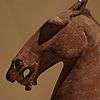Gansu Flying Horse


The Gansu Flying Horse or Han dynasty Flying Horse, Bronze Running Horse (铜奔马 Tóng bēn mǎ) or Galloping Horse Treading on a Flying Swallow (马踏飞燕 Mǎtà fēiyàn) is a Chinese sculpture in bronze from the Eastern Han dynasty probably the 2nd century CE. Discovered in 1969 near the city of Wuwei, in the province of Gansu, it is now in the Gansu Provincial Museum. "Perfectly balanced," says one authority, "on the one hoof which rests without pressure on a flying swallow, it is a remarkable example of three-dimensional form and of animal portraiture with the head vividly expressing mettlesome vigor." [1]
Discovery and world fame
The horse was found in 1969, during the Cultural Revolution, by a team of locals who had been told to dig air-raid shelters in fear of war with the Soviet Union. When they excavated they found a chamber under a monastery which held a group of over 200 bronze figurines of men, horses, and chariots, which they put in plastic bags and took home.
They later realized the importance of their find and reported it to provincial authorities. Professional archaeologists then took up the excavations. They discovered a three-chambered tomb which had apparently been entered by looters soon after the original burial some 2,000 years earlier. The looters had not, however, entered the chamber in which the bronzes were found. The archaeologists determined that the opulent tomb was that of a Han dynasty army general who had been given the important task of maintaining imperial frontier defenses. They took the bronzes to the museum in Lanzhou.[2]
In Lanzhou, the group of bronzes was observed by Guo Moruo, China's elder statesman of archaeology and history, who was conducting Cambodian Prince Sihanouk on a tour of China. Guo was struck by the beauty of the horse and selected it for national and international exhibition.[2]
The horse in the bronze is a breed brought back from Fergana, a by a punitive expedition sent by Emperor Han Wudi in 104 BCE. These "celestial horses" were highly prized as marks of status.[3]
Although scholars pointed out that the bird was not in fact a swallow, the piece was exhibited in many countries in the 1970s as "Galloping Horse Treading on a Flying Swallow."
In 2002, the State Administration of Cultural Heritage of China included the Gansu Flying Horse in the inaugural list of 64 grade-one cultural relics that are forbidden to be taken out of mainland China for exhibition.[4][5]
References
- Honour, Hugh; Fleming, John (2005). A World History of Art. Laurence King. ISBN 9781856694513.
- Man, John (2008). The Great Wall. Cambridge, MA: Da Capo Press. ISBN 9780306817670.
Notes
- ↑ HonourFleming (2005), p. Ch 6.
- 1 2 Man (2008), p. 98-101.
- ↑ Silk Road Foundation
- ↑ 国家文物局发出通知 首批一级文物禁止出国(境)展览. Chinese Cultural Heritage Protection. Retrieved 2015-02-03.
- ↑ 国家文物局发出通知 首批一级文物禁止出国(境)展览. china-culture.com.cn. Retrieved 2015-02-03.
| Wikimedia Commons has media related to Category:Galloping Horse Treading on a Flying Swallow. |
